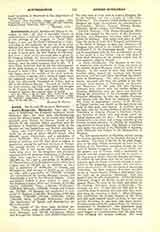

Austremonius, Saint, Apostle and Bishop of Auvergne (c. 314). All that is certainly known of Austremonius is deduced from a few brief sentences in the writings of St. Gregory of Tours (Hist. Franc., I, xxx, and De Gloria Confessorum, c. xxix). According to this authority he was one of the seven bishops sent from Rome into Gaul about the middle of the third century; he labored in Auvergne and is said to have been the first Bishop of Clermont. But from a study of the episcopal lists as given by St. Gregory himself, St. Austremonius could hardly have antedated the commencement of the fourth century, since his third successor died in 385. It is more likely, therefore, that he was the contemporary of the three Bishops of Aquitaine who attended the Council of Arles in 314. He was not a martyr. His cult began about the middle of the sixth century, when Cantius, a deacon, saw a vision of angels about his neglected tomb at Issoire on the Couse. His body was afterwards translated to Volvic, and in 761 to the Abbey of Mauzac. Towards the middle of the ninth century, the head of the saint was brought to St.-Yvoine, near Issoire, and about 900 was returned to Issoire, the original place of burial.
FRANCIS P. HAVEY

